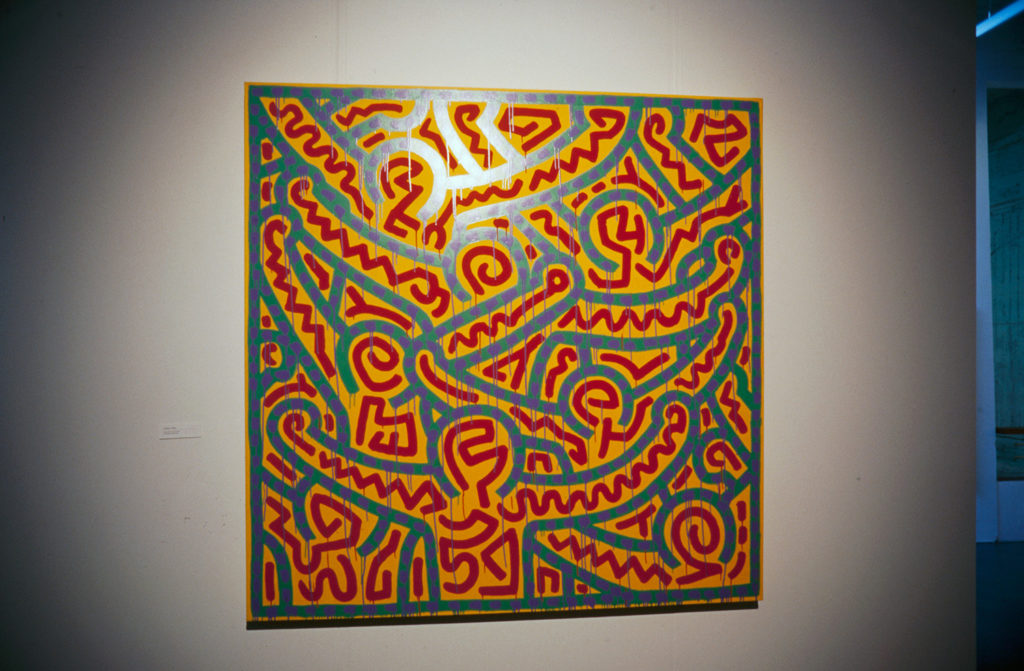CURATOR Elizabeth Sussman ORGANISER Whitney Museum of American Art, New York OTHER VENUES Whitney Museum of American Art, 25 June–12 September 1997; Art Gallery of Ontario, Toronto; Museum of Contemporary Art, Miami; San Francisco Museum of Modern Art; Musee des Beaux-Arts, Montreal PUBLICATION texts Jeffrey Deitch, David Frankel, Ann Magnuson, Robert Pincus-Witten, Elizbeth Sussman, Robert Farris Thompson
The radiant baby arrives in Civic Square. Curated by New York's Whitney Museum, the touring Keith Haring retrospective makes its only Australasian stop at City Gallery. It traces the evolution of Haring’s art until his death from AIDS at age 31 in 1990.
A shy kid from Pennsylvania, Haring first became known as a graffiti artist, for his quickly executed chalk drawings on unused advertising panels in New York subway stations. He could make dozens in a single day. As his fame grew, fans tore down his drawings and souvenired them. Soon Haring was showing in prominent galleries and museums around the world. With his bold, comic-like representations of radiant babies, barking dogs, and dancing figures, he became one of the most famous artists of the 1980s.
A celebrity himself, Haring worked with Grace Jones, Brooke Shields, Andy Warhol, and William Burroughs, and hung out with Madonna. His drawings appeared on Swatch watches and Absolut vodka ads. He opened his Pop Shop in New York, selling T-shirts and toys, posters, buttons, and magnets, ‘getting art off the pedestals and giving it back to the people’. His public projects ranged from an animation for the Spectacolor billboard in New York’s Times Square to a mural on the Berlin Wall. During the last years of his life, he used his work to increase AIDS awareness. In 1989, he established the Keith Haring Foundation.
The City Gallery show emulates the spaces in which Haring’s work was originally shown, including the subway and nightclubs. The nightclub space plunges the viewer into a day-glo world, accompanied by the dance, pop, Latin music that Haring listened to in his studio. Salon hangs emphasise Haring’s productivity. The City Gallery installation is designed by Andrew Thomas, working from the original designs by Tibor Kalman (founder of M and Co.) and Richard Pandiscio (Interview magazine’s creative editor at large).
In addition to paintings, sculptures, and drawings, photos and videos document site-specific public works and performances. One video shows Haring dancing and painting at the same time. He also appears in the Grace Jones music clip I’m Not Perfect (but I’m Perfect for You) painting a giant white dress, that she later wears. There are also vitrines of ephemera and celebrity photos.
The public programme includes talks by Dean Hapeta (Upper Hutt Posse), Paul Miller (aka DJ Spooky), and David Stark. Listener rock critic Nick Bollinger addresses 1980s American music. Author Peter Wells compares gay literature from the US and New Zealand. Dick Frizzell and his son Otis speak during the family Fun Day. The Gallery also operates its own Pop Shop.
There is a big marketing campaign. Saatchi & Saatchi TV ads feature ‘real people’ responding to images of Haring’s work. Graffiti artists Otis Frizzell, Daniel Tippet, and DLT paint council caravans throughout the city with interpretations of Haring’s works. There’s also a RadioSpungo campaign at venues ranging from Victoria University to the vegetable section of the Cable Street New World. (After the Spungo chief plants a FM receiver in the vegetable section that transmits a short broadcast on the Haring show, he’s chased out of the store by security.)
Most of the media, however, is generated by the Christian Heritage Party, which takes issue at the Family Fun Day. (It includes a map of the show that steers children past the X-rated drawings.) Christian Heritage submits eighteen Haring works to the Office of Film and Literature Classification. The Gallery enlists prominent advocates, including the Tate’s Nicholas Serota, to write letters of support. The show receives a PG classification, so no works are removed. (Graham Capill, the then leader of Christian Heritage will later be convicted for child-sex offences.) The group City Gallery Watch also write to school principals, advising them to boycott the show.
The opening is attended by Juliet Gruen, from the Haring Foundation, and David Stark, from the Haring estate. Musician Gareth Farr shows up as alter-ego Lilith LaCroix, adding a certain ‘je ne sais quoi'.
In the Herald, TJ McNamara says, ‘Seeing Haring’s work only in reproduction, it is easy to dismiss him as a reputation created by publicity. But the experience of a big exhibition such as this is convincing evidence of his enormous talent and place in the art of this half-century.’ However, in Listener critic Justin Paton describes the show as ‘bloated’, ‘a Hip Hop theme park’, and an exercise in ‘transforming yesterday’s glamour into today’s sale tickets’. A sell out? Not quite. Ticket sales fall short of expectations.

































































































































